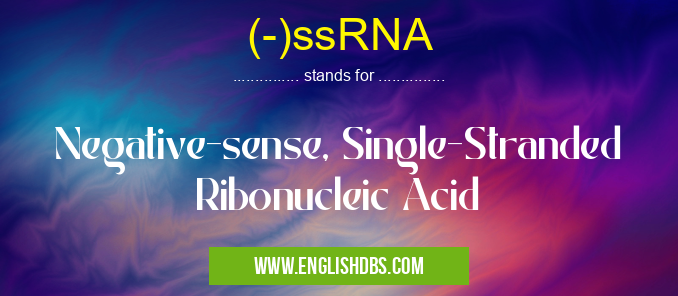What does (-)SSRNA mean in CHEMISTRY
(-)ssRNA stands for Negative-sense, Single-Stranded Ribonucleic Acid. It is a type of RNA molecule that has a complementary strand to the mRNA (messenger RNA) strand. In other words, the (-)ssRNA strand is not directly translated into protein, but rather must first be transcribed into a positive-sense RNA strand.

(-)ssRNA meaning in Chemistry in Academic & Science
(-)ssRNA mostly used in an acronym Chemistry in Category Academic & Science that means Negative-sense, Single-Stranded Ribonucleic Acid
Shorthand: (-)ssRNA,
Full Form: Negative-sense, Single-Stranded Ribonucleic Acid
For more information of "Negative-sense, Single-Stranded Ribonucleic Acid", see the section below.
Characteristics of (-)ssRNA
- Negative-sense: The (-)ssRNA strand is complementary to the mRNA strand, meaning that it has the opposite sequence of bases.
- Single-stranded: The (-)ssRNA strand is not paired with another strand of RNA, unlike double-stranded RNA (dsRNA).
- Ribonucleic acid: (-)ssRNA is composed of ribonucleotides, which are molecules that contain the sugar ribose.
Function of (-)ssRNA
(-)ssRNA is found in some viruses, such as influenza viruses and measles viruses. In these viruses, the (-)ssRNA strand is transcribed into a positive-sense RNA strand by a viral RNA-dependent RNA polymerase. The positive-sense RNA strand is then translated into viral proteins.
Essential Questions and Answers on Negative-sense, Single-Stranded Ribonucleic Acid in "SCIENCE»CHEMISTRY"
What is (-)ssRNA?
(-)ssRNA stands for Negative-sense, Single-Stranded Ribonucleic Acid. It is a type of RNA molecule that cannot be directly translated into protein. Instead, it must first be converted into a positive-sense RNA strand by an RNA-dependent RNA polymerase.
How does (-)ssRNA differ from positive-sense RNA?
Unlike positive-sense RNA, (-)ssRNA is not complementary to the mRNA that it encodes. Instead, it is complementary to the coding strand of DNA. This means that (-)ssRNA must be converted into a positive-sense RNA strand before it can be translated into protein.
What viruses have (-)ssRNA genomes?
Many viruses have (-)ssRNA genomes, including rabies virus, influenza virus, and measles virus.
How is (-)ssRNA replicated?
(-)ssRNA viruses replicate using an RNA-dependent RNA polymerase. This enzyme uses the (-)ssRNA genome as a template to synthesize a positive-sense RNA strand. The positive-sense RNA strand is then used as a template to synthesize new (-)ssRNA genomes.
What are the implications of (-)ssRNA for vaccine development?
The fact that (-)ssRNA viruses must first convert their genomes into positive-sense RNA before they can be translated into protein makes them more difficult to develop vaccines against. This is because traditional vaccines typically use inactivated or attenuated viruses. However, new vaccine technologies are being developed that are specifically designed to target (-)ssRNA viruses.
Final Words: (-)ssRNA is a type of RNA molecule that is found in some viruses. It is complementary to the mRNA strand and must be transcribed into a positive-sense RNA strand before it can be translated into protein.
